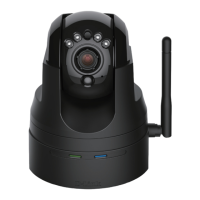
Do you have a question about the D-Link DCS-5029L and is the answer not in the manual?
| Brand | D-Link |
|---|---|
| Model | DCS-5029L |
| Category | Security Camera |
| Language | English |
Lists revisions, dates, and descriptions of manual updates.
Lists D-Link and third-party trademarks and copyright information.
Hazards like strangulation, choking, and not a toy.
Indoor use only, avoid water, heat sources, secure mounting.
Lists reliance on external services for functionality.
Lists all items included in the product packaging.
Lists OS, browser, and PC hardware requirements.
Specifies network connection requirements.
Lists requirements for mydlink service.
Highlights mydlink integration and wired/wireless options.
Details pan/tilt, IR LEDs, and motion detection capabilities.
Identifies and describes front components of the camera.
Easiest setup using a D-Link Cloud Router.
Guided setup for users without a Cloud Router.
Manual steps for hardware setup.
Steps for connecting power and Ethernet cables.
Registering the camera with the mydlink account.
Step-by-step guide for wireless connection via WPS.
Instructions for obtaining and launching the setup wizard.
Steps for connecting cables and initial configuration.
Explains the mydlink service for remote access.
Lists and describes available mydlink apps.
Explains online status indicators (green, yellow, red).
Steps to resolve camera offline issues.
Using SD card for recording and viewing files.
Device name, MAC, firmware, and activation details.
Configuring email alerts and motion detection.
Accessing advanced settings and unregistering the device.
Accessing the camera's web interface.
Controls for pan, tilt, zoom, and preset navigation.
Adjusting video stream settings and interface language.
Table of icons and buttons on the live video screen.
Introduces wizards for internet, motion detection, etc.
DHCP, Static IP, and PPPoE settings.
Configuring DDNS, camera name, and time zone.
Reviewing and saving network configuration.
Configuring detection areas, sensitivity, and schedules.
Setting up alerts and saving motion detection settings.
Configuring DHCP, Static IP, UPnP, and PPPoE.
Configuring ports and stream access names.
Managing QoS, CoS, and IPV6 settings.
Activating wireless and scanning for SSIDs.
Configuring authentication, encryption, and keys.
Settings for enabling DDNS, server, host, user, password.
Privacy masking, anti-flicker, mirror, flip, power line, white balance.
Exposure mode, denoise, brightness, contrast, saturation, sharpness.
Choosing mount type for accurate PTZ operation.
Setting aspect ratio, codec, frame size, and quality.
Configuring microphone and speaker levels.
Setting pan/tilt increments, presets, and home position.
Configuring auto pan speed and creating movement sequences.
Setting up video/PIR motion detection and sensitivity.
Using drawing mode to specify monitored areas.
Activating sound detection and setting the trigger level.
Configuring time zone and DST adjustments.
Setting time manually or via NTP server.
Defining event conditions and resulting actions.
Setting up servers for data storage.
Defining media types for events.
Configuring event schedules and recording settings.
Setting up Email, FTP, Network Storage, or SD Card servers.
Configuring snapshots, video clips, and system logs.
Detailed settings for snapshots and video clips.
Naming events, setting priority, delay, and triggers.
Scheduling events by day/time and defining digital output actions.
Setting up recording entries and schedules.
Configuring file size, duration, and naming conventions.
Managing files and formatting the SD card.
Configuring digital input/output behavior.
Configuring automatic, scheduled, day, or night modes.
Controlling IR light (Off, On, Sync, Schedule).
Activating HTTPS and creating certificates.
Managing IP addresses for camera access permissions.
Changing admin password and managing user access.
OSD, labels, time, LED, privacy, and calibration.
Backing up, loading, and resetting configurations.
Rebooting the device and scheduling reboots.
Steps to download and upload new firmware.
Shows camera and network settings, MAC, firmware version.
Displaying, downloading, and clearing system logs.
Navigating to help sections for further information.
Lists necessary hardware for manual setup.
Guide for manual installation behind a router.
Finding the router's WAN IP address via its interface.
Step-by-step guide to configure router's Virtual Server.
Enabling remote access and resetting forgotten passwords.
Resolving blurry images, network problems, and LEDs.
Addressing missing images and PIR sensor performance.
OS, browser, network protocols, and security.
Codecs, frame rates, resolutions, and video features.
Lens, sensor, IR, viewing angle, dimensions, power, temp.
EMI, safety, and regulatory certifications.
Details the function and connection of DI/DO pins.
Details required information before contacting support.
Provides phone and web support details for US and Canada.
Manually configure IP settings on Windows 8.
Manually configure IP settings on Windows 7/Vista.
Details warranty terms for hardware and software.
Conditions not covered and how to submit claims.
Specific steps for filing claims in different regions.
Lists items not covered by warranty and disclaimers.
FCC and Industry Canada compliance, warnings.
Encourages online product registration for warranty.